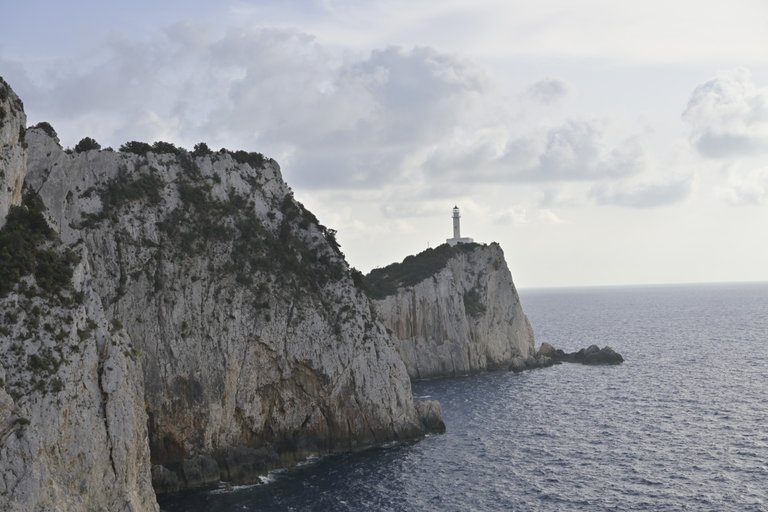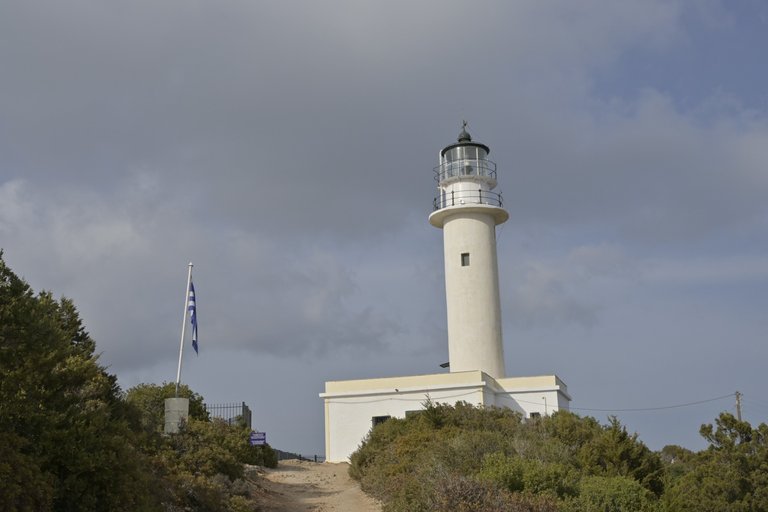[ENG]
After spending the first half of the day on the beach, we decided to move a bit and explore the southern regions of Lefkada. For this reason, we headed to the very south of the island to the Lefkatas cape, also known as the Doukato cape. The cape is made of high white rocks protruding almost 50 meters above the water level. At the very end of the cape there is a historic lighthouse built in 1890. It operated continuously until World War II, when it was turned off. It was not until 1945, when the war turmoil in Greek lands calmed down a bit, that the decision was made to restart the lighthouse. Unfortunately, after 8 years, in 1953, Lefkada was hit by an earthquake that damaged the structure of the lighthouse and caused it to be turned off again. Ultimately, the golden years for the Doukato cape lighthouse came only after Greece joined the European Union and the inflow of funds from the Brussels budget. Then, in 1985, the lighthouse was electrified and has been operating continuously to this day.
[PL]
Po pierwszej połowie dnia spędzonej na plażowaniu postanowiliśmy przemieścić się trochę i pozwiedzać południowe rejony Lefkady. Z tego powodu ruszyliśmy na samo południe wyspy na przylądek Lefkatas zwany także przylądkiem Doukato. Przylądek zbudowany jest z wysokich białych skał wystających ponad poziom wody na wysokość niemal 50 metrów ponad poziom morza. Na samym końcu przylądku znajduje się historyczna latarnia morska zbudowana jeszcze w roku 1890. Działała ona nieprzerwanie aż do czasu II wojny światowej, kiedy to została wyłączona. Dopiero w roku 1945 gdy na ziemiach Greckich wojenna zawierucha uspokoiła się trochę podjęto decyzję o ponownym uruchomieniu latarni. Pechowo się złożyło, bo już po 8 latach czyli w roku 1953 Lefkadę nawiedziło trzęsienie ziemi, które uszkodziło konstrukcję latarni i spowodowało ponowne jej wyłączenie. Finalnie złote lata dla latarni morskiej na przylądku Doukato nastały dopiero po wejściu Grecji do Unii Europejskiej i przypływie środków z budżetu brukselskiego. Wówczas w roku 1985 latarnia została zelektryfikowana i nieprzerwanie działa aż do dzisiaj.
[ENG]
The place is so charming that in ancient times it was decided to build a sanctuary there in honor of the god of art, music, poetry and generally understood beauty, i.e. Apollo. Every year religious ceremonies were held there, the purpose of which was to propitiate the gods of the sea, which is especially important for the people living on the island. During these ceremonies, it is said that even human sacrifices were made. Most often, these were convicts or sick people who were simply thrown off a cliff into the depths of the sea. The Greeks also call the cape of Cape Lefkatas Kavos tis Kiras, which translates as the Cape of the Lady, and this is because there are legends related to the figure of Sappho around this place. According to legends, the ancient poet Sappho fell in love with an old man named Phaon, who had previously been made beautiful and young again by the goddess Aphrodite. Unfortunately, Sappho's love was not reciprocated, and after his love for her was rejected, she committed suicide by jumping into the sea from that very rock. I don't know what to think about this, because Wikipedia says something completely different. According to Wikipedia, Sappho returned with a broken heart to her birthplace, Lesbos, where she lived to a ripe old age.
[PL]
Miejsce jest tak bardzo urokliwe, że w starożytności zdecydowano się zbudować tam sanktuarium ku czci boga sztuki, muzyki, poezji i ogólnie wszelako rozumianego piękną czyli Apolla. Co roku przeprowadzano tam ceremonie religijne, których celem było przebłaganie bogów morza, co dla ludzi żyjących na wyspie jest szczególnie ważne. Podczas tych uroczystości pon0oć składano nawet ofiary z ludzi. Najczęściej byli to skazańcy lub osobę chorą które po prostu zrzucano z klifu w odmęty morskie.
Grecy przylądwek Przylądek Lefkatas nazywają również Kavos tis Kiras co się tłumaczy jako Przylądek Damy, a to dlatego, że wokół tego miejsca krążą legendy związane z postacią Safony. Według legend starożytna poetka Safona zakochała się w starcu o imieniu Faon, którego uprzednio bogini Afrodyta uczyniła na nowo pięknym i młodym. Niestety miłość Safony nie została odwzajemnion, a po odrzuceniu jej miłosnych zapędów popełniła samobójstwo skacząc do morza właśnie z tej skały. Nie wiem co o tym sądzić, bo Wikipedia mówi cos zupełnie innego. Zgodnie z Wikipedią Safona ze złamanym sercem wróciła do miejsca swojego urodzenia czyli na Lesbos, gdzie dożyła późnej starości.














Amazing and beautiful view of these landscapes. Nice shots @olusiu
!discovery shots
!LUV
Looks like a very nice picture my friend
What a virtual your this is. Thanks for sharing.
a place that has an amazing view, nice shot
This is a very amazing view
I’m sure you had a nice experience as well
wow this is totally amazing 😍
I always find lighthouses fascinating
traveling in virtual is good for now. looking for your post and I'm waiting for the next.
This is a legendary lighthouse working for centuries, and the location is stunning. Hope you have enjoyed the trip with the surrounding beauty. Thanks for sharing.
You can check out this post and your own profile on the map. Be part of the Worldmappin Community and join our Discord Channel to get in touch with other travelers, ask questions or just be updated on our latest features.
Congratulations, your post has been added to the TravelFeed Map! 🎉🥳🌴
Did you know you have your own profile map?
And every post has their own map too!
Want to have your post on the map too?
- Go to TravelFeed Map
- Click the create pin button
- Drag the marker to where your post should be. Zoom in if needed or use the search bar (top right).
- Copy and paste the generated code in your post (any Hive frontend)
- Or login with Hive Keychain or Hivesigner and click "create post" to post to Hive directly from TravelFeed
- Congrats, your post is now on the map!
PS: You can import your previous Pinmapple posts to the TravelFeed map.Opt Out
This post was shared and voted inside the discord by the curators team of Discovery-it in collaboration with Visual Shots community.
Discovery-it is also a Witness, vote for us here
Delegate to us for passive income. Check our 80% fee-back Program
Congratulations @olusiu! You received the biggest smile and some love from TravelFeed! Keep up the amazing blog. 😍 Your post was also chosen as top pick of the day and is now featured on the TravelFeed front page.
Thanks for using TravelFeed!
@for91days (TravelFeed team)
PS: Why not share your blog posts to your family and friends with the convenient sharing buttons on TravelFeed?
Travel Digest #2397.
Become part of our travel community:
- Join our Discord
Hiya, @lizanomadsoul here, just swinging by to let you know that this post made it into our Honorable Mentions in Your post has been manually curated by the @worldmappin team. If you like what we're doing, please drop by to check out all the rest of today's great posts and consider supporting other authors like yourself and us so we can keep the project going!Love this! Last time when I was here Vasiliki was the furthest I went down but I saw the cape from here. Also when I sailed to Kefalonia later in the week I had a good shot at the cape so it is cool to see it now from the top as well.
Lefkas is really something and a really cool island!
Reading about Cape Lefkatas makes me dream of standing there myself, feeling the breeze from the high cliffs and looking out over the endless blue sea.
I liked the story about the lighthouse, especially how it went through so many ups and downs, rebuilding after the war and the earthquake. The legend of Sappho is, of course, impressive, although the information from Wikipedia contradicts the story, and I was a little confused about what exactly happened to her. Nevertheless, it all creates an incredible atmosphere😍
Hello olusiu!
It's nice to let you know that your article won 🥈 place.
szejq Your post is among the best articles voted 7 days ago by the @hive-lu | King Lucoin Curator by
You and your curator receive 0.0327 Lu (Lucoin) investment token and a 6.26% share of the reward from Daily Report 501. Additionally, you can also receive a unique LUSILVER token for taking 2nd place. All you need to do is reblog this report of the day with your winnings.
Buy Lu on the Hive-Engine (Lucoin) and get paid. With 50 Lu in your wallet, you also become the curator of the @hive-lu which follows your upvote. exchange | World of Lu created by @szejq
STOPor to resume write a wordSTART